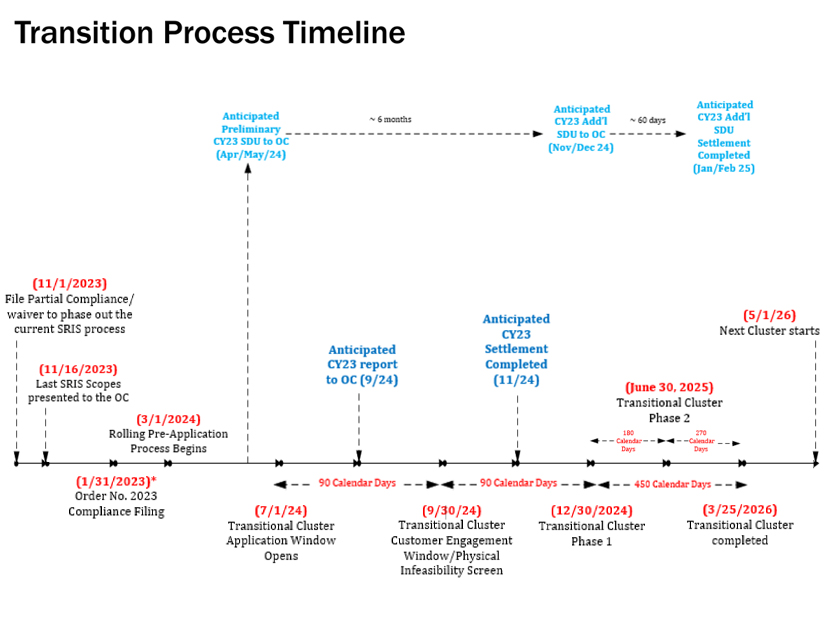RENSSELAER, N.Y. — NYISO said it will submit a partial compliance filing for FERC Order 2023 early next month, aiming to get a head start on full compliance and minimize challenges associated with the transition to a new interconnection process.
NYISO attorney Sara Keegan told the Interconnection Issues Taskforce Oct. 20 that the ISO “wants to hit the ground running” in complying with FERC’s order, which seeks to clear backlogged interconnection queues through a clustered study approach. (See FERC Updates Interconnection Queue Process with Order 2023.)
NYISO’s partial filing will request that FERC eliminate the system reliability impact study (SRIS) requirement for pending queue projects, provide more options for pending projects to proceed through the queue and eliminate developers’ option for detailed feasibility studies.
Thinh Nguyen, NYISO senior manager of interconnection projects, said the proposals “seek to streamline the study process” and remove redundancies by “eliminating any unnecessary parts of the study process.”
Phasing out certain queue studies lets staff allocate their “limited resources more wisely,” since they are not only working to comply with Order 2023, but also still reviewing projects moving through the ISO’s current interconnection processes, Nguyen added. (See NYISO Begins 2023 Class Year with Nearly 100 Projects.) The ISO’s last interconnection SRIS project scopes will be presented to the Operating Committee for approval this month.
Zachary Stines, director of wholesale market development at Borrego Solar, asked why NYISO was making only a partial compliance filing.
Keegan responded that the partial filing is “very limited,” covering only what the ISO plans on doing during the interim period between December and the effective date of the full compliance filing.
“We want to be ready by the first cluster and be able to put all our resources into that, and not have to be winding down studies that provide no benefit in the new process,” she said.
Nguyen concurred, saying later, “We want to avoid shooting from the hip and be able to get everything figured out as quickly as possible for developers.”
Staff promised to continue the discussions and present stakeholder comments on the ISO’s proposals at future IITF meetings.
Compliance Extension Request
Staff also reiterated that NYISO intends to seek an extension of the Order 2023 compliance deadline from Dec. 5 to the end of January or start of February. (See NYISO to Ask FERC for Order 2023 Compliance Extension.)
On Oct. 2, the New England Power Pool Participants Committee requested a 45-day delay of the deadline. That followed an Aug. 28 filing by SPP, PJM and MISO requesting that FERC delay the compliance date from 90 days after the final rule’s publication in the Federal Register until at least 90 days after the commission issues a substantive order addressing arguments on clarification and rehearing (RM22-14).
The commission issued a notice Sept. 28 noting that rehearing requests in the docket were rejected after FERC failed to respond within 30 days. The three RTOs subsequently filed petitions asking federal appellate courts to review Order 2023. Other challenges have been filed by PacifiCorp, First Energy and Advanced Energy United.
Staff at the IITF noted that the ISO’s motion could be filed irrespective of the commission’s decision on the other RTOs’ extension request.
“We may file before the commission decides, since we expected an order by now on the [other extension requests], and we will probably ask for an [extension] tailored to our particular circumstances,” Keegan said.
Keegan said NYISO is looking for flexibility from the commission to minimize the impacts associated with transitioning to Order 2023’s cluster study processes.
“It might be longer or shorter than other [requests],” Keegan added, “but we have a unique situation in terms of the timing of our queue reforms.” He said the ISO wants to get everything into place before the start of the first cluster.
This need for flexibility was echoed in the compliance extension motions filed by other RTOs, who argued it would be difficult for them to both comply with FERC’s directives and ask for more details on Order 2023.
“Requiring transmission providers to make compliance filings while many have pending requests for rehearing and clarification creates regulatory uncertainty and imposes a regulatory burden on some transmission providers and stakeholders as they seek to comply with the final rule while also undertaking their own RTO-specific reform effort,” read the motion filed jointly by PJM, MISO and SPP.

